Self-Portraits Help Count Cats: WCS Research Fellow Santiago Espinosa Conducts First-ever Jaguar Census in Ecuador
Jaguars are the largest cats of the Americas and third largest cats in the world. The primary rainforest in the Amazon region of Ecuador is among their last remaining strongholds. Jaguars are listed as “vulnerable” in Ecuador, and Santiago Espinosa, Wildlife Conservation Society (WCS) fellow, PhD candidate from University of Florida/Gainesville, and WWF fellow, wants to know just how many jaguars are left in his home country. He is developing strategies to protect them by determining their numbers and the factors that threaten them through a unique method of non-invasive photography.
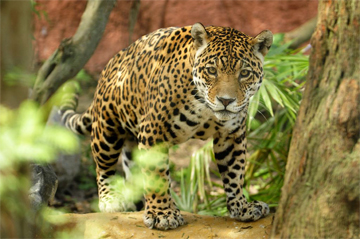 A jaguar, the largest cat of the Americas. Credit: Julie Larsen Maher ©WCS 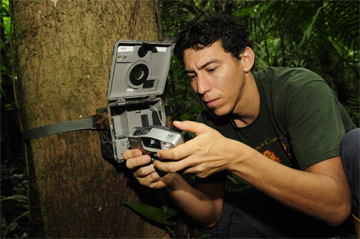 Santiago Espinosa sets up a camera trap, one of 52 at this site, in the rainforest along the Tiputini River in Ecuador. Credit: Julie Larsen Maher ©WCS |
Espinosa is conducting the first large-scale big cat count in Ecuador by placing camera traps (cameras that are activated by the heat of a passing animal) throughout the Amazon rainforest of Yasuní National Park (YNP), one of the most biologically diverse places on the planet. The jaguars literally photograph themselves as they pass by the cameras he has set up in some of the most remote regions in the country. These cat “self-portraits” provide Espinosa with visual identification of individual jaguars (each cat’s coat spot pattern is unique), and thus, their densities in a given range. The cameras even take photos of jaguar prey like peccaries (wild pigs native to the Americas.) He began to develop the project in 2005 together with the Waorani, a group of indigenous people who live within the Amazon rainforest of Ecuador. His camera work began in 2007.
Jaguars are part of the ecosystem of Ecuador’s YNP and the adjacent Waorani Ethnic Reserve. Together, these places form the largest protected area in Ecuador (close to 4.2 million acres), and are among the highest in potential for jaguar conservation in the country. These protected lands have long been home to indigenous people and wildlife that have survived together through time–sharing both space and resources. Historically, human densities were relatively low and scattered throughout the forest, and pressure on wildlife was sustainable.
Today, the struggle is on between protecting YNP and the ever-increasing oil exploration within the park that expands Ecuador’s economic growth. The entire ecosystem is at risk as oil extraction, with its invasive infrastructure like roads, has catalyzed cultural change in the region while putting people and wildlife in competition for food and territory.
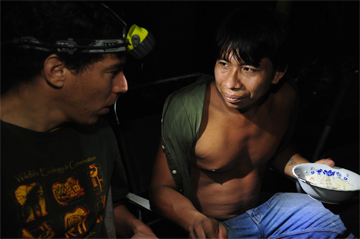 Santiago Espinosa and Matias Alvarado, Waorani field assistant for jaguar camera trapping, meet each night to plan the next day’s camera trap activities. Credit: Julie Larsen Maher ©WCS 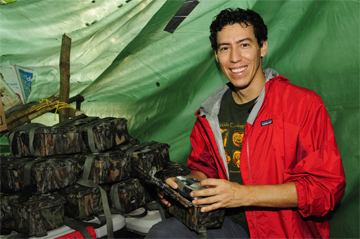 Santiago Espinosa with more than 50 camera traps that he must take to each field location to gather photos in the rainforest. Credit: Julie Larsen Maher ©WCS 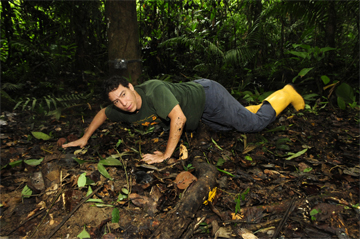 Santiago Espinosa simulates the movements of a jaguar in the forest to ensure the camera traps are working properly in the rainforest. Credit: Julie Larsen Maher ©WCS |
“The main threats to jaguars in Ecuador are habitat degradation and loss due to various human activities,” says Espinosa. “Bushmeat hunting by local communities has increased due to road development that provides access to otherwise isolated areas. Additionally, people hunt bushmeat to sell commercially in local markets (also made more accessible by roads), rather than simply for their own consumption. There is competition for food as people hunt the same prey species (such as peccaries and deer) as the jaguar. If the prey species disappear, the jaguar will be gone.”
Jaguars are, by nature, reclusive and rare. Although he has traversed over 300 miles of rugged rainforest in search of them, Espinosa has never seen one. He relies on the non-invasive camera traps and the photos they produce to tell him about jaguar activities like their preference for day or night and even the reproductive stages of females. The best use of camera traps, however, is to estimate how many jaguars live within a certain area. Jaguar numbers indicated by analyzing their photographs will help to determine how much space they need to survive.
Espinosa’s work for conserving cats has three parts:
- Placing camera traps in areas where human populations and development are established and in remote areas frequented by few people to estimate the difference in numbers of jaguar and prey species between hunted and non-hunted sites.
- Working with local communities of Waorani to gather data on how much bushmeat they extract, and for what purpose (i.e., for consumption or for commercial sale.)
- Teaching methods to the Waorani to monitor wildlife and creating awareness of conservation issues within the rainforest communities.
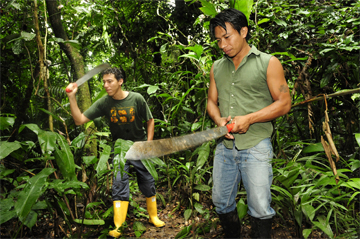 Matias Alvarado, Waorani field assistant for jaguar camera trapping, with Santiago Espinosa, open up a clearing to position camera traps for jaguars. Credit: Julie Larsen Maher ©WCS 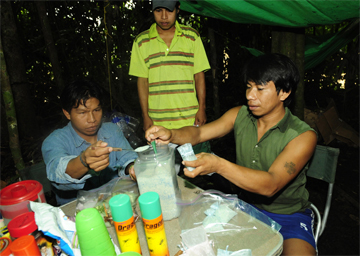 Field assistants from the indigenous communities of Waorani and Kichwa–Jorge Gaba, Jairo Andi, and Matias Alvarado–prepare packets of silica to place inside the camera traps. Silica protects the cameras by absorbing moisture from the rain and humidity in the forest. They are using “wedding favor” bags – the perfect size and porosity for the silica. Credit: Julie Larsen Maher ©WCS 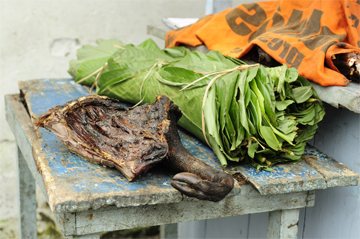 Bushmeat is sold illegally in local markets. Overhunting of jaguar prey species like the peccary is a threat to its survival. Credit: Julie Larsen Maher ©WCS 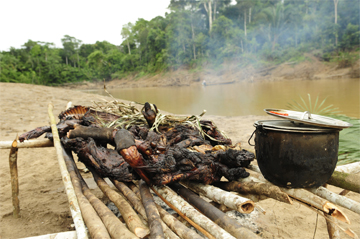 Bushmeat is sold illegally in local markets. Overhunting of jaguar prey species like the peccary is a threat to its survival. Credit: Julie Larsen Maher ©WCS 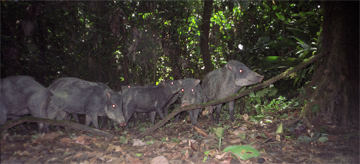 Camera traps also photograph jaguar prey like the white-lipped peccary. Overhunting of jaguar prey species like the peccary is a threat to its survival. Credit: © Santiago Espinosa 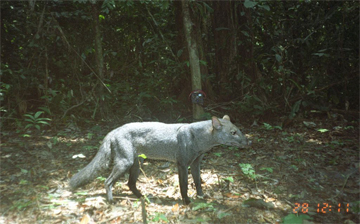 A short-eared dog appeared in a recent set of camera trap images. The dog is a very rare species from the Amazon rainforest that is largely unknown even to local people. Credit: © Santiago Espinosa 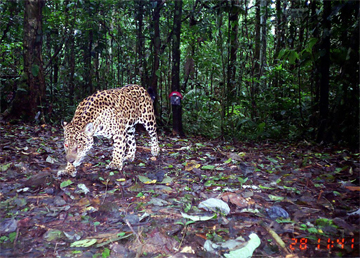 A jaguar’s body heat sets off the camera traps in the rainforest and takes his “self-portrait”. Credit: © Santiago Espinosa |
The conditions to gather jaguar photos are difficult. Espinosa and his team of Waorani are in the thick, hot, humid air of the rainforest for weeks at a time with no electricity, no communication, no running water, no bathroom, and their best friend is a sharp-edged machete. They share their often water-logged tents with a variety of oversized stinging, biting insects. These arduous field trips are necessary to identify the potential paths and patterns jaguars take through their range in the rainforest.
Espinosa operates camera traps at four different study sites of approximately 25,000 acres each. Two sites have high levels of hunting and are close to communities and accessible by oil exploration roads, and two sites are in remote areas that are far from roads. At each site, Espinosa distributes cameras in 26 locations. Two cameras are placed across from one and other along a predetermined path so as to photograph both sides of the jaguars that pass through them. Cameras work continuously for 90 days, although they require twice-a-month check ups to ensure the film is advancing, the batteries are working, and that moisture from the off-and-on rains has not shut the cameras down completely.
In his first survey at a highly hunted site within YNP, Espinosa identified three different jaguar individuals. At his second study site in a rarely hunted and remote area close to the southern border of YNP, he has distinguished 14 different jaguars—almost five times as many as near the populated site.
Espinosa has recently established a third camera survey in a remote area near the Tiputini River at the northern border of YNP and will begin the fourth survey in March 2009, again close to a community along an oil company road. He has taken about 75 photos of jaguar so far, with hundreds of other animals making guest appearances on his film as well. A recent set of images featured a short-eared dog, a very rare species from the Amazon rainforest that is largely unknown even to local people.
Espinosa has plans to extend the jaguar camera trap surveys to other areas of Ecuador, both in the Amazon region and along the coast where most of the forests are gone, but may still provide refuge to jaguars. He hopes to build a monitoring program of jaguar and prey species that will provide ongoing information about their populations, and to continue working closely with local communities to conserve the Ecuadorian rainforest and wildlife for them and for the world.
In addition to WCS’s over 600 field projects around the world, the Society operates five wildlife parks in the New York area. One of them, the Queens Zoo, is planning a Central and South American jaguar educational exhibit that will be home to a breeding pair of jaguar. It is scheduled to open in 2010. There are fewer than 100 jaguars living in zoos in North America.
Julie Larsen Maher is WCS Staff Photographer. She documents WCS field work on location and made a recent trip to the rainforest of Ecuador.
Santiago Espinosa is a PhD candidate in the Department of Wildlife Ecology and Conservation at the University of Florida – Gainesville.
TAKE ACTION
UPDATES